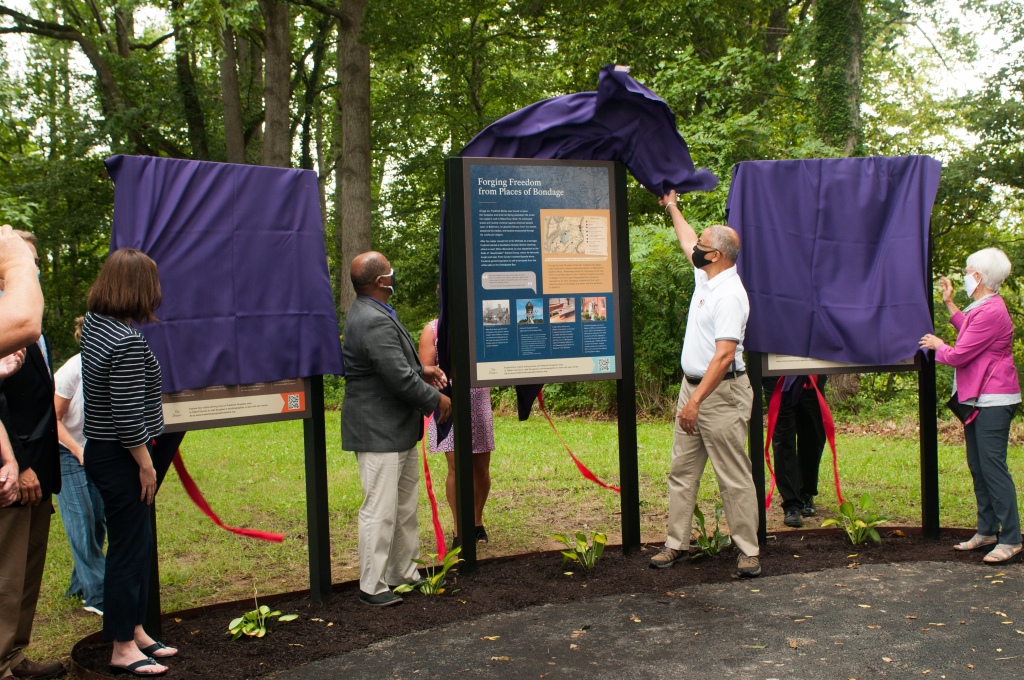By Ennis Barbery Smith, Assistant Administrator, Maryland Heritage Areas Program

Frederick Douglass – the widely recognized abolitionist, human rights activist, orator, writer, and son of Maryland’s Eastern Shore – is one of the original pillars of Black History Month. Although documentation indicates he was born in February 1818, he did not know the exact date. After fleeing Maryland to self-emancipate, he chose to celebrate his birthday on February 14, and celebrations of February 14 as “Douglass Day” popped up shortly after his death in 1895. Eventually, Carter G. Woodson laid the foundations of Black History Month in February – in part – because Black communities were already celebrating Douglass’s life and contributions around this time.
While the exact date was uncertain, Douglass knew the location. In the first chapter of one of his autobiographies, he says, “I was born in Tuckahoe, near Hillsborough, and about twelve miles from Easton, in Talbot County, Maryland.”

Photo by Mark Sandlin, provided courtesy of Talbot County Tourism
The new Frederick Douglass Park on the Tuckahoe is taking shape as a place where visitors can come to reflect on Douglass’s time in Maryland, not just during Black History Month, but in any season – even during a pandemic, when many indoor history museums have limited capacity.
Talbot County acquired the 107 acres of shoreline and wetlands for the park in 2006 using Program Open Space funding. Cassandra Vanhooser, Talbot County’s Director of Economic Development and Tourism, said that it was clear to her immediately when she learned about this land, in close proximity to Frederick Douglass’s privately owned birthplace, that the new park was well positioned to honor Douglass’s legacy and to share the story of his life with visitors.
The County pulled together a team of historians, local leaders, and Frederick Douglass descendants to guide the development of the new park. In 2018, the Maryland Heritage Areas Authority (MHAA) awarded a matching grant to Talbot County for the creation of two plans: a master plan to map out the park’s infrastructure and an interpretive plan to explore the stories that the park will evoke for visitors. After a series of public meetings and many hours of behind-the-scenes work, the County hopes to share these plans with the public in March of 2021.

Photo by Mark Sandlin, provided courtesy of Talbot County Tourism
Ms. Vanhooser described the park’s unspoiled wetlands and viewshed, saying, “This is the landscape into which Douglass was born, the world that shaped his youth.” She went on to say “What Douglass was able to accomplish in his life is extraordinary by any measure. His words transcend time and place. They are as inspiring today as they ever were, and that is why we are telling Frederick Douglass’s story here.”
When visitors make their way to the park today, they will find serene, undeveloped views of the Tuckahoe River, evocative of what Douglass would have seen in his lifetime. Four new interpretive signs located at the park describe Douglass’s life on the Tuckahoe, his journey away from Maryland to freedom, and his important roles as a conductor on the Underground Railroad and as an internationally recognized voice for the abolition of slavery.

Photo by Melissa Grimes-Guy, provided courtesy of Talbot County Tourism
The park is also one stop on a series of four driving tours, shared here, that guide visitors through the landscapes and the places that Douglass experienced in Talbot County. The new interpretive signs and the website showcasing the driving tours were funded in part by the Stories of the Chesapeake Heritage Area (SCHA), with funds from MHAA.
Gail Owings, Executive Director of SCHA, spoke of the importance of the new park. She said the local heritage area is thrilled to be able to support the County’s efforts. She added “the views of the landscape and water – they set the stage for Douglass’s life,” emphasizing how closely tied the park’s viewsheds are with what Douglass would have seen in his youth, an important time that he reflects on in his writings.
Visitors can also explore Douglass’s connections to other regions of Maryland by following this state-wide driving tour developed by Maryland Office of Tourism.
